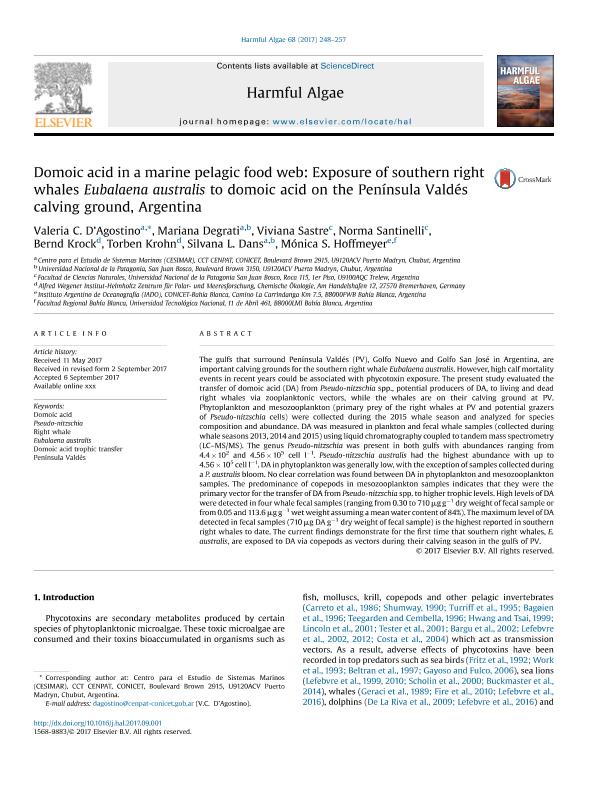Mostrar el registro sencillo del ítem
dc.contributor.author
D'agostino, Valeria Carina

dc.contributor.author
Degrati, Mariana

dc.contributor.author
Sastre, Viviana
dc.contributor.author
Santinelli, Norma Herminia

dc.contributor.author
Krock, Bernd
dc.contributor.author
Krohn, Torben
dc.contributor.author
Dans, Silvana Laura

dc.contributor.author
Hoffmeyer, Monica Susana

dc.date.available
2018-04-23T15:43:48Z
dc.date.issued
2017-09
dc.identifier.citation
D'agostino, Valeria Carina; Degrati, Mariana; Sastre, Viviana; Santinelli, Norma Herminia; Krock, Bernd; et al.; Domoic acid in a marine pelagic food web: Exposure of southern right whales Eubalaena australis to domoic acid on the Península Valdés calving ground, Argentina; Elsevier Science; Harmful Algae; 68; 9-2017; 248-257
dc.identifier.issn
1568-9883
dc.identifier.uri
http://hdl.handle.net/11336/43012
dc.description.abstract
The gulfs that surround Península Valdés (PV), Golfo Nuevo and Golfo San José in Argentina, are important calving grounds for the southern right whale Eubalaena australis. However, high calf mortality events in recent years could be associated with phycotoxin exposure. The present study evaluated the transfer of domoic acid (DA) from Pseudo-nitzschia spp., potential producers of DA, to living and dead right whales via zooplanktonic vectors, while the whales are on their calving ground at PV. Phytoplankton and mesozooplankton (primary prey of the right whales at PV and potential grazers of Pseudo-nitzschia cells) were collected during the 2015 whale season and analyzed for species composition and abundance. DA was measured in plankton and fecal whale samples (collected during whale seasons 2013, 2014 and 2015) using liquid chromatography coupled to tandem mass spectrometry (LC?MS/MS). The genus Pseudo-nitzschia was present in both gulfs with abundances ranging from 4.4 × 102 and 4.56 × 105 cell l−1. Pseudo-nitzschia australis had the highest abundance with up to 4.56 × 105 cell l−1. DA in phytoplankton was generally low, with the exception of samples collected during a P. australis bloom. No clear correlation was found between DA in phytoplankton and mesozooplankton samples. The predominance of copepods in mesozooplankton samples indicates that they were the primary vector for the transfer of DA from Pseudo-nitzschia spp. to higher trophic levels. High levels of DA were detected in four whale fecal samples (ranging from 0.30 to 710 μg g−1 dry weight of fecal sample or from 0.05 and 113.6 μg g−1 wet weight assuming a mean water content of 84%). The maximum level of DA detected in fecal samples (710 μg DA g−1 dry weight of fecal sample) is the highest reported in southern right whales to date. The current findings demonstrate for the first time that southern right whales, E. australis, are exposed to DA via copepods as vectors during their calving season in the gulfs of PV.
dc.format
application/pdf
dc.language.iso
eng
dc.publisher
Elsevier Science

dc.rights
info:eu-repo/semantics/openAccess
dc.rights.uri
https://creativecommons.org/licenses/by-nc-sa/2.5/ar/
dc.subject
Domoic Acid
dc.subject
Pseudo-Nitzschia
dc.subject
Right Whale
dc.subject
Eubalaena Australis
dc.subject
Domoic Acid Trophic Transfer
dc.subject
PenÍNsula ValdÉS
dc.subject.classification
Otras Ciencias Biológicas

dc.subject.classification
Ciencias Biológicas

dc.subject.classification
CIENCIAS NATURALES Y EXACTAS

dc.title
Domoic acid in a marine pelagic food web: Exposure of southern right whales Eubalaena australis to domoic acid on the Península Valdés calving ground, Argentina
dc.type
info:eu-repo/semantics/article
dc.type
info:ar-repo/semantics/artículo
dc.type
info:eu-repo/semantics/publishedVersion
dc.date.updated
2018-04-05T18:24:44Z
dc.journal.volume
68
dc.journal.pagination
248-257
dc.journal.pais
Países Bajos

dc.journal.ciudad
Amsterdam
dc.description.fil
Fil: D'agostino, Valeria Carina. Consejo Nacional de Investigaciones Científicas y Técnicas. Centro Científico Tecnológico Conicet - Centro Nacional Patagónico. Centro para el Estudio de Sistemas Marinos; Argentina
dc.description.fil
Fil: Degrati, Mariana. Consejo Nacional de Investigaciones Científicas y Técnicas. Centro Científico Tecnológico Conicet - Centro Nacional Patagónico. Centro para el Estudio de Sistemas Marinos; Argentina. Universidad Nacional de la Patagonia; Argentina
dc.description.fil
Fil: Sastre, Viviana. Universidad Nacional de la Patagonia; Argentina
dc.description.fil
Fil: Santinelli, Norma Herminia. Universidad Nacional de la Patagonia; Argentina
dc.description.fil
Fil: Krock, Bernd. Alfred Wegener Institut-Helmholtz Zentrum für Polar; Alemania
dc.description.fil
Fil: Krohn, Torben. Alfred Wegener Institut-Helmholtz Zentrum für Polar; Alemania
dc.description.fil
Fil: Dans, Silvana Laura. Consejo Nacional de Investigaciones Científicas y Técnicas. Centro Científico Tecnológico Conicet - Centro Nacional Patagónico. Centro para el Estudio de Sistemas Marinos; Argentina. Universidad Nacional de la Patagonia; Argentina
dc.description.fil
Fil: Hoffmeyer, Monica Susana. Consejo Nacional de Investigaciones Científicas y Técnicas. Centro Científico Tecnológico Conicet - Bahía Blanca. Instituto Argentino de Oceanografía. Universidad Nacional del Sur. Instituto Argentino de Oceanografía; Argentina. Universidad Tecnológica Nacional. Facultad Regional Bahía Blanca; Argentina
dc.journal.title
Harmful Algae

dc.relation.alternativeid
info:eu-repo/semantics/altIdentifier/doi/http://dx.doi.org/10.1016/j.hal.2017.09.001
dc.relation.alternativeid
info:eu-repo/semantics/altIdentifier/url/https://www.sciencedirect.com/science/article/pii/S1568988317301269
Archivos asociados
